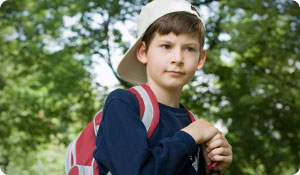
"Common sense tells you that having a 30- or 40-pound backpack isn't good for kids," says Ben W. Kittredge, MD, an orthopedic surgeon with Commonwealth Orthopaedics in Alexandria, Virginia. He explains that a too heavy load could stress the vertebra and cause pain. Orthopedists generally recommend that a child's backpack plus its contents weigh no more than 10 percent of his or her body weight. So, if you have a 70-pound 4th grader, she shouldn't be carrying a backpack that weighs more than 7 pounds.
Wearing a backpack incorrectly-slung over one shoulder, for example-can also lead to soreness, poor posture, and excessive slouching. Harvard Medical School claims 21,000 injuries related to backpacks were treated in 2002 and the U.S. Consumer Product Safety Division reported that 7,000 people were sent to the ER for backpack-related injuries in 2001.
According to the American Academy of Orthopedic Surgeons a backpack that hangs two inches above the waist is optimal. Wearing both straps keeps the bag positioned properly against the back instead of down by the pelvic bone. (A backpack that hangs low puts more weight on the shoulders.)
Jason Villani, a New Jersey-based doctor of chiropractic, says heavy backpacks can pull the vertebra pull out of place. "The skilled hands of a chiropractor can manipulate the vertebra back where it belongs," says the chiropractor adding that the painful area would also be treated with heat and ice.
Help Them Lighten Their Load
If you notice your child leaning to one side, bending forward when he walks, or having difficulty standing upright you should probably have him evaluated by a chiropractor or physician. Here, a few safety guidelines from the American Academy of Pediatrics:
- Purchase a backpack with wide, padded shoulder straps that can be adjusted to fit properly on your child.
- For particularly heavy loads, use a hip strap which will help distribute the weight evenly between the back and the hips.
- Pack the bag properly. Put the heaviest items in the backpack first. Ideally, most of the weight should rest over the top of the hip bones as opposed to the upper back which causes greater back strain.
- When lifting a heavy pack, teach your child to bend at the knees and use her legs to lift.
- Encourage your kids to use folders instead of lugging everything home at the end of the school day. Have him bring home just the work she needs for homework. At school, encourage your child to take frequent trips in between classes to her locker for book exchanges.
- If your school allows it, consider purchasing a backpack on wheels or keep an extra set of books for home use.
Sources:
Interview with Ben W. Kittredge, MD
Commonwealth Orthopaedics, Alexandria, VA
Interview with Jason Villani, of Villani Chiropractic in Verona, NJ
www.villanichiropractic.com/
The American Chiropractic Association
www.Acatoday.org
American Academy of Pediatrics
www.healthykids.org
Harvard Medical School
www.harvard.med.edu





